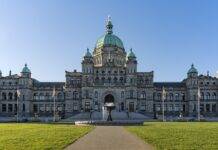The emerging centre of economic gravity is China, and in October, Mayor Dean Fortin led a 26-person economic and education delegation to visit British Columbia’s second largest trading partner.
During the 10-days excursion, the delegation of representatives from the Greater Victoria Development Agency, and the tourism, education and tech sectors, visited six Chinese cities, including Shanghai. Douglas asked Mayor Dean Fortin for highlights and lessons.
Douglas: Tell us about your recent visit to China. What were the highlights?
We had an opportunity through our trade delegations to promote three of the major sectors within the Greater Victoria region: tourism, education, and high tech. Within that context, the trade delegation created both opportunities and relationships on the ground — everything from meeting with more than 50 tour operators who put packages together to ensure that Victoria is part of those tour packages, to meeting with municipalities (in China, tourism is run by municipalities), and an opportunity to create a joint marketing [initiative] with the city of Suzhou.
[In Suzhou], they get more than 14 million visitors a year; we get 3.5 million, so there will be cross marketing for us using Facebook and Twitter, and for them using the Chinese equivalent of Renen and Weibo. So both of us are marketing on each other’s behalf to the tourism market.
What about the trip’s benefits for the education sector?
With universities and colleges, it was a great opportunity to support the University of Victoria [UVic], Royal Roads University, and Camosun College as well as School District 63 … At UVic they have a strong relationship with the University of Hunan — and, of course, Royal Roads welcomed its first 40 students into its environmental management program, which is fantastic not only for the university but, frankly, for training the next managers concerned about environmental impact in China. That’s the first time [this program has] been recognized by the government of China.
Each one of those students represents about $40,00 per student to the local economy. It’s estimated that all students combined add about a million a year to the economy. That not only creates local wealth but allows the universities to, frankly, keep tuition low and invest in facilities that have a benefit for our local students.
And did you connect with investors interested in the private sector?
There were some great preliminary meetings with investors who either have opportunity for local companies to find a partner to get into the Chinese market or for people to attract some foreign investment to help their companies be successful.
Is that mostly in high tech?
Generally, in the high-tech area investors are going over [to China] looking for an opportunity and looking to the City to help guide them in making these connections.
Did you discover specific things we can do in Victoria to improve our readiness to do business with China?
The short answer is yes. The difficulty, to a certain extent, is an awareness of how to do business in China. That’s something the mayor’s office can facilitate: how to do business in China and who to do business with in China. Often, the perception is “If I can just get to China, you know, it’s 1.5 billion people, and if I sell them all one pair of socks, I’ve made it!” The truth is, you have to be strategic, you have to be focused, and you have to use the resources that are available. It’s something that, at the municipal level we can help with. Our provincial representatives in China are outstanding, and at the mayor’s level, we can also facilitate the work with the Canadian government over there. Those opportunities to connect and move things forward are extremely important.
What issues do we face in doing business with China?
The federal government issues visas and it is taking six to eight weeks for it to happen, whereas in the United States it’s three to four days. That interferes with tour operators, with investors coming over, and with the free flow of trade and people … Literally, students are waiting to get their visas and classes have started but they can’t get into the country. It’s one thing to sign them up; it’s another to help them arrive.
The other issue highlighted was that there is great interest in expanding tourism in Victoria … but the size of our [airport] runway restricts what we can attract. So the [delay of] the airport runway expansion of the airport, in my mind, remains one of the largest impediments to future economic development, whether it be flights from high-tech companies from San Francisco or from China, which would like to look at instituting a once-a-week direct flight.
How was ‘brand Victoria’ received?
What was really important, and quickly became noticeable, is that because we were following up on a 2010 trip (and in 2011 we had received delegations in Victoria) our follow-up in 2012 reinforced our city’s interest in doing business. So the welcoming, frankly, was twice as warm and the opportunities twice as good — and it was almost like they realized we were serious in trying to promote Victoria’s economy.
So we’ll see Victoria heading back in the future?
Yes, in the future — and I think we’ve really proven it’s a worthwhile investment for the city and people, and to a certain extent it’s creating both wealth and employment for cities in both countries and that’s a good thing. Creating jobs, building sustainable employment. That’s important.























